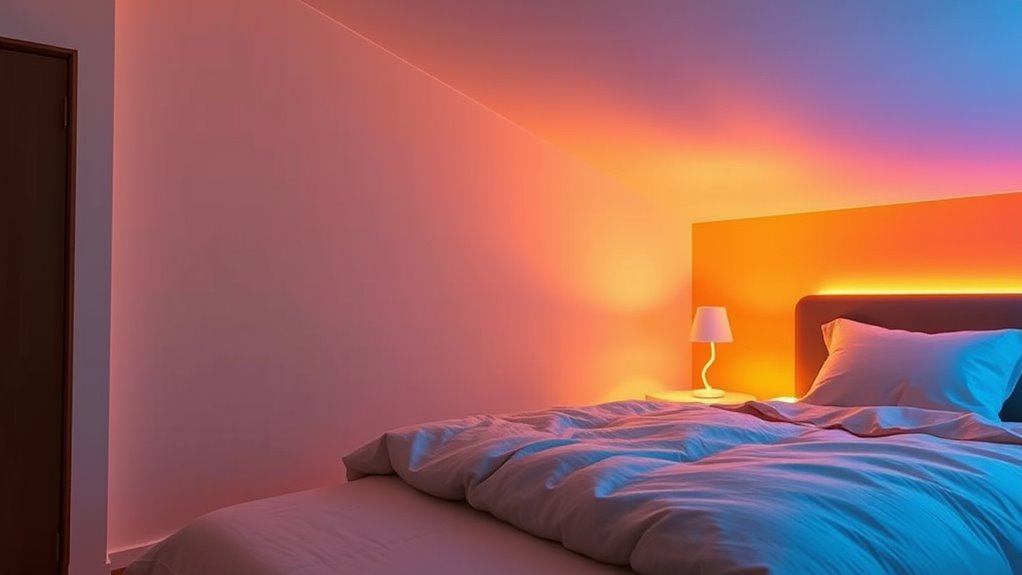Circadian lighting uses smart bulbs to mimic natural light patterns, helping you align your sleep cycle and boost your mood. By adjusting color temperature and brightness throughout the day, these bulbs signal your brain when to feel alert or sleepy, just like sunlight does. Using cooler, bright light during the day and warmer, softer light at night can reset your internal clock naturally. Explore how these lighting tricks can improve your well-being as you continue to learn more.
Key Takeaways
- Circadian bulbs adjust color temperature to mimic natural light, signaling your body to wake or wind down.
- Bright, bluish-white light during the day boosts alertness by suppressing melatonin.
- Warmer, softer light in the evening promotes melatonin production, aiding sleep readiness.
- Smart bulbs can automate lighting transitions, reinforcing your natural circadian rhythm.
- Properly timed lighting supports mood, energy levels, and helps reset disrupted sleep cycles.

Have you ever noticed how your energy levels fluctuate throughout the day? It’s not just in your head—your body responds to the light around you, especially the color temperature of that light. This is where circadian lighting comes into play, leveraging the natural rhythms your body follows to regulate sleep, alertness, and overall health. By adjusting the color temperature of your indoor lighting, you can influence your biological clock, making it easier to stay awake when you need to be alert and wind down when it’s time to sleep.
During the day, exposure to light with a higher color temperature—think bright, bluish-white light—mimics natural sunlight. This type of light acts as a form of light therapy, signaling your brain that it’s daytime, boosting alertness, and suppressing melatonin, the sleep hormone. When you’re in environments with cool, blue-toned lighting, you’re more likely to stay focused and energized. Conversely, as evening approaches, shifting to warmer, lower color temperature lighting, like soft amber or orange hues, mimics sunset. This *shift* helps your body recognize that it’s time to wind down, encouraging melatonin production and preparing you for restful sleep.
Using circadian lighting isn’t just about comfort; it’s a strategic way to hack your sleep cycle. If you work late or wake up early, adjusting your lighting can help reset your internal clock gradually, reducing jet lag or sleep difficulties. Some smart bulbs allow you to schedule these changes automatically, gradually dimming and shifting color temperature throughout the day. This mimics natural light patterns, reinforcing your circadian rhythm rather than disrupting it.
Light therapy, in particular, has proven effective for those experiencing seasonal affective disorder or irregular sleep patterns. By exposing yourself to bright, properly timed light, you can enhance your mood and regulate your sleep-wake cycle more effectively. The key is timing—getting bright light exposure in the morning supports wakefulness, while dim, warm light in the evening signals your body to prepare for sleep.
Incorporating circadian lighting into your daily routine is a simple yet powerful way to support your natural rhythms. It’s not just about convenience; it’s about optimizing your health. When you pay attention to the color temperature of your lighting, you’re actively helping your body maintain a balanced sleep cycle, improving both your energy during the day and your rest at night. Understanding light’s impact on health can empower you to make better choices about your environment and enhance your overall well-being.
Frequently Asked Questions
Can Circadian Lighting Improve Alertness During the Day?
You can boost your alertness during the day with circadian lighting, which mimics natural light patterns. Exposure to blue light helps regulate your circadian rhythm, making you more awake and focused. By using bulbs that adjust throughout the day, you get the right amount of blue light when needed, improving your energy and productivity. This smart lighting keeps your internal clock aligned, helping you stay alert when it matters most.
Are There Any Health Risks Associated With Circadian Lighting?
You might wonder if circadian lighting poses health risks. While it can improve alertness and sleep, long-term effects are still being studied. You should also consider eye safety, as improper lighting may cause eye strain or discomfort over time. Overall, using circadian bulbs correctly is key. Stay informed and consult experts if you have concerns about potential health risks or long-term effects related to your lighting choices.
How Does Circadian Lighting Affect People With Sleep Disorders?
If you have sleep disorders, circadian lighting can influence your melatonin regulation, potentially improving sleep quality. Proper lighting can reduce sleep disruption by syncing with your natural rhythms, helping your body produce melatonin at the right times. However, if not used correctly, it might worsen sleep issues. You should experiment with lighting adjustments and consult a specialist to find the best setup for your needs.
Can Smart Bulbs Automatically Adjust to My Sleep Schedule?
You might wonder if smart bulbs can automatically adjust to your sleep schedule. Many smart bulbs offer compatibility with various devices and apps, making automatic scheduling simple. Once set up, they can change brightness and color temperature based on your preferred routine. This means you don’t need to manually control them; instead, they adapt seamlessly, helping you maintain a consistent sleep pattern and improve overall rest.
What Are the Best Color Temperatures for Different Times of Day?
Did you know that our alertness peaks in the late morning and dips in the early evening? Your color temperature preferences play a big role in this; cooler lights (around 5000K) boost focus during the day, while warmer tones (around 2700K) help you wind down in the evening. For ideal lighting schedules, switch to daylight hues in the morning and warm, soft lighting at night to support your natural rhythm.
Conclusion
By embracing circadian lighting, you can harness the power of your environment to improve your sleep, energy, and overall health. It’s like having a personal sleep coach right in your bulbs, subtly guiding your body’s natural rhythms. Yet, just as artificial light can disrupt your cycle, the right lighting can restore it. So, don’t let your bulbs be the enemy; let them become your allies in achieving better sleep and a more balanced life.










